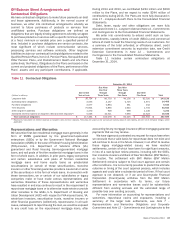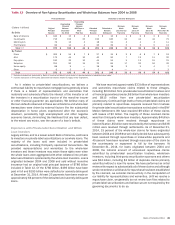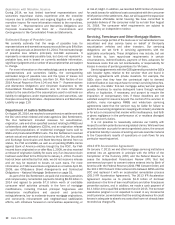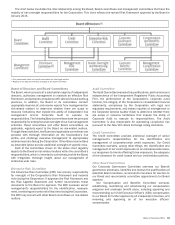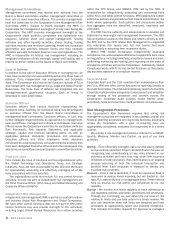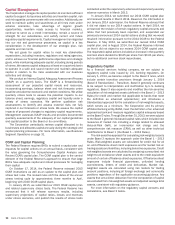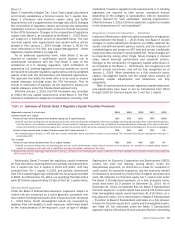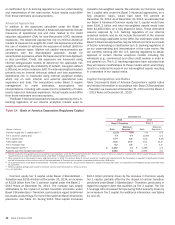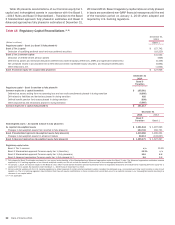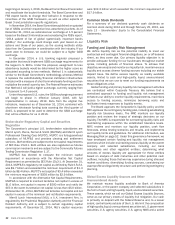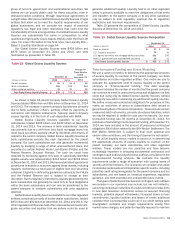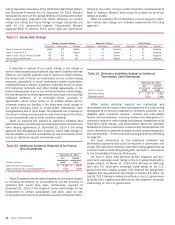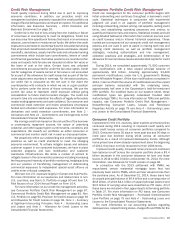Bank of America 2014 Annual Report Download - page 59
Download and view the complete annual report
Please find page 59 of the 2014 Bank of America annual report below. You can navigate through the pages in the report by either clicking on the pages listed below, or by using the keyword search tool below to find specific information within the annual report.
Bank of America 2014 57
Basel 3
Basel 3 materially changes Tier 1 and Total capital calculations
and formally establishes a Common equity tier 1 capital ratio.
Basel 3 introduces new minimum capital ratios and buffer
requirements and a supplementary leverage ratio (SLR); changes
the composition of regulatory capital; and revises the adequately
capitalized minimum requirements under the Prompt Corrective
Action (PCA) framework. Changes to the composition of regulatory
capital under Basel 3, as compared to the Basel 1 – 2013 Rules,
are subject to a transition period as described below. The new
minimum capital ratio requirements and related buffers will be
phased in from January 1, 2014 through January 1, 2019. For
more information on the SLR, see Capital Management – Other
Regulatory Capital Matters on page 61.
As an advanced approaches bank, under Basel 3, we are
required to complete a qualification period (parallel run) to
demonstrate compliance with the final Basel 3 rules to the
satisfaction of U.S. banking regulators. Upon notification of
approval by U.S. banking regulators to exit our parallel run, we will
be required to calculate regulatory capital ratios and risk-weighted
assets under both the Standardized and Advanced approaches.
The approach that yields the lower ratio is to be used to assess
capital adequacy including under the PCA framework. Prior to
receipt of notification of approval, we are required to assess our
capital adequacy under the Standardized approach only.
Effective January 1, 2015, the PCA framework was amended
to reflect the new capital requirements under Basel 3. The PCA
framework establishes categories of capitalization, including “well
capitalized,” based on regulatory ratio requirements. U.S. banking
regulators are required to take certain mandatory actions
depending on the category of capitalization, with no mandatory
actions required for “well capitalized” banking organizations.
Effective January 1, 2015, Common equity tier 1 capital is included
in the measurement of “well capitalized.”
Regulatory Capital Composition – Transition
Important differences in determining the composition of regulatory
capital between the Basel 1 – 2013 Rules and Basel 3 include
changes in capital deductions related to our MSRs, deferred tax
assets and defined benefit pension assets, and the inclusion of
unrealized gains and losses on AFS debt and certain marketable
equity securities recorded in accumulated OCI. These changes will
be impacted by, among other things, future changes in interest
rates, overall earnings performance and corporate actions.
Changes to the composition of regulatory capital under Basel 3,
as compared to the Basel 1 – 2013 Rules, are recognized in 20
percent annual increments, and will be fully recognized as of
January 1, 2018. When presented on a fully phased-in basis,
capital, risk-weighted assets and the capital ratios assume all
regulatory capital adjustments and deductions are fully
recognized.
Table 13 summarizes how certain regulatory capital deductions
and adjustments have been or will be transitioned from 2014
through 2018 for Common equity tier 1 and Tier 1 capital.
Table 13 Summary of Certain Basel 3 Regulatory Capital Transition Provisions
Beginning on January 1 of each year 2014 2015 2016 2017 2018
Common equity tier 1 capital
Percent of total amount deducted from Common equity tier 1 capital includes: 20% 40% 60% 80% 100%
Deferred tax assets arising from net operating loss and tax credit carryforwards; intangibles, other than mortgage servicing rights and goodwill; defined benefit pension
fund net assets; net unrealized cumulative gains (losses) related to changes in own credit risk on liabilities, including derivatives, measured at fair value; direct and
indirect investments in own Common equity tier 1 capital instruments; certain amounts exceeding the threshold by 10 percent individually and 15 percent in aggregate
Percent of total amount used to adjust Common equity tier 1 capital includes (1): 80% 60% 40% 20% 0%
Net unrealized gains (losses) on AFS debt and certain marketable equity securities recorded in accumulated OCI; employee benefit plan adjustments recorded in
accumulated OCI
Tier 1 capital
Percent of total amount deducted from Tier 1 capital includes: 80% 60% 40% 20% 0%
Deferred tax assets arising from net operating loss and tax credit carryforwards; defined benefit pension fund net assets; net unrealized cumulative gains (losses)
related to changes in own credit risk on liabilities, including derivatives, measured at fair value
(1) Represents the phase-out percentage of the exclusion by year (e.g., 20 percent of net unrealized gains (losses) on AFS debt and certain marketable equity securities recorded in accumulated OCI
will be included in 2014).
Additionally, Basel 3 revised the regulatory capital treatment
for Trust Securities, requiring them to be partially transitioned from
Tier 1 capital into Tier 2 capital in 2014 and 2015, until fully
excluded from Tier 1 capital in 2016, and partially transitioned
from Tier 2 capital beginning in 2016 with the full amount excluded
in 2022. As of December 31, 2014, our qualifying Trust Securities
were $2.9 billion (approximately 23 bps of the Tier 1 capital ratio).
Standardized Approach
Under the Basel 3 Standardized approach, exposures subject to
market risk are measured on a basis generally consistent with
how market risk-weighted assets were measured under the Basel
1 – 2013 Rules. Credit risk-weighted assets are measured by
applying fixed risk weights to each exposure, determined based
on the characteristics of the exposure, such as type of obligor,
Organization for Economic Cooperation and Development (OECD)
country risk code and maturity, among others. Under the
Standardized approach, no distinction is made for variations in
credit quality for corporate exposures, and the economic benefit
of collateral is restricted to a limited list of eligible securities and
cash. We estimate our Common equity tier 1 capital ratio under
the Basel 3 Standardized approach, on a fully phased-in basis,
would have been 10.0 percent at December 31, 2014. As of
December 31, 2014, we estimate that our Basel 3 Standardized
Common equity tier 1 capital would have been $141.2 billion and
total risk-weighted assets would have been $1,415 billion, on a
fully phased-in basis. For a reconciliation of Basel 3 Standardized
– Transition to Basel 3 Standardized estimates on a fully phased-
in basis for Common equity tier 1 capital and risk-weighted assets,
see Table 16. Our estimates under the Basel 3 Standardized
approach may be refined over time as a result of further rulemaking


